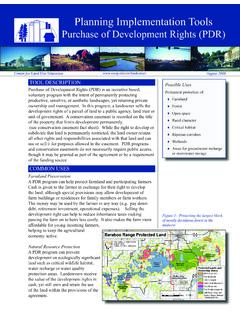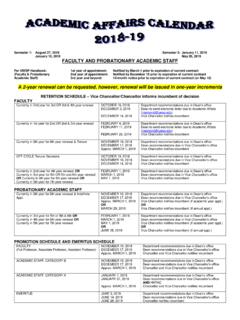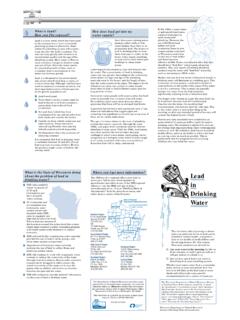Transcription of Planning Implementation Tools Capital Improvement Plan
1 Planning Implementation ToolsCapital Improvement PlanA Capital Improvement plan (CIP) is a community Planning and fi scal management tool used to coordinate the location, timing and fi nancing of Capital improvements over a multi-year period usually 4-6 years. Capital improvements refer to major, non-recurring physical expenditures such as land, buildings, public infrastructure and equipment. The CIP includes a description of proposed Capital Improvement projects ranked by priority, a year-by-year schedule of expected project funding, and an estimate of project costs and fi nancing sources.
2 The CIP is a working document and should be reviewed and updated annually to refl ect changing community needs, priorities and funding Capital BudgetingPreparation of the CIP and annual budget are closely linked. The fi rst year of the CIP, known as the Capital budget, outlines specifi c projects and appropriates funding for those projects. It is usually adopted in conjunction with the government s annual operating budget. Projects and fi nancing sources outlined for subsequent years are not authorized until the annual budget for those years is legally adopted.
3 The out years serve as a guide for future Planning and are subject to further review and modifi cation. Plan ImplementationThe CIP is a powerful tool for implementing a community s comprehensive plan, strategic plan, and other Planning documents. Capital investments such as utility extensions, highway improvements, and the purchase of parkland or environmental corridors can have a substantial impact on patterns of growth and development . By providing funding for strategic investments at a given time and location, the CIP helps ensure that development occurs consistent with a community s plans and 1: The Capital Improvement plan is used to identify, prioritize and assign funding to major Capital expenditures such as land, buildings, public infrastructure and equipment.
4 Center for Land Use EducationSeptember DESCRIPTIONCOMMON USES Purposes of Capital Improvement Planning :Ensure the timely repair and replacement of aging infrastructure. Provide a level of certainty for residents, businesses and developers regarding the location and timing of public investments. Identify the most economical means of fi nancing Capital improvements. Provide an opportunity for public input in the budget and fi nancing unanticipated, poorly planned, or unnecessary Capital expenditures. Eliminate sharp increases in tax rates, user fees and debt levels to cover unexpected Capital improvements.
5 Ensure that patterns of growth and development are consistent with the comprehensive desired public improvements with the community s fi nancial following general steps are involved in preparing a Capital Improvement plan:Project Submission1. Local agencies and departments are asked to submit a list of Capital Improvement projects in order of priority. Project request forms may prompt the applicant to provide a project description and justifi cation, an estimate of initial project costs, ongoing operating and maintenance costs, and recommended funding sources.
6 Evaluation and Selection2. The CIP team reviews, prioritizes and selects projects based on specifi c criteria, such as: desired service level standard project demand, as determined by an inventory of existing land, equipment and facility conditionsnumber of residents or geographic area served return on investment, cost savings or revenue generation sustainability or energy effi ciency improvements economic, environmental, aesthetic or social impacts public health, safety or other legal concerns consistency with community plans and policies public or political support Financial Analysis3.
7 Financial data, including historic and projected local government revenues, expenditures and debt service are used to assess the community s ability to pay for proposed projects and to select appropriate fi nancing Preparation4. The draft CIP includes a list of recommended projects by funding year, project and scheduling details, and fi nancing sources. Detailed maps, photos, graphs, timelines and other illustrations may accompany the and Adoption5. Following public review and revisions, the governing body adopts the CIP and Capital single offi cial is usually responsible for coordinating preparation of the CIP.
8 This task may be assigned to the chief executive or administrative offi cer (mayor, president, manager, administrator), a budget offi cer, or a member of the Planning , fi nance or public works departments. The CIP coordinator often works with an advisory committee which may consist of local offi cials, citizens, or key departmental staff. It is also a good idea to refer the CIP to the plan commission for review and approval. In most communities, the CIP is prepared in the months preceding adoption of the annual government budget. To provide suffi cient time for project solicitation, fi nancial analysis and community input, preparation of the CIP may take on a year-round function in some communities.
9 The CIP should be reviewed and updated 2. 3. 4. 5. ADA sof admbuddepcomdepplatheannsoltheWhat is a Capital Improvement ? Most communities defi ne Capital improvements as major public expenditures, usually physical in nature. Local policies may specify the cost and useful life of qualifi ed projects. For example, a small community may set minimum project costs at $1,000 or $2,500, while larger communities set the threshold at $10,000 or $25,000. Expenses below this level are considered operational and appear in the annual budget. The Government Finance Offi cers Association recommends a useful service life of at least three to fi ve years.
10 Common categories of Capital expenditures include:Purchase of major equipment 1. (ex. playground equipment, snow plow, computers).Acquisition of land for a 2. public purpose (ex. park, landfi ll, industrial site).Construction, expansion 3. or major renovation of a public building or facility (ex. library, roads, sewage treatment plant, building retrofi t for energy effi ciency).Related Planning , 4. engineering, design, appraisal or feasibility costs (ex. LEED certifi cation, architectural fees). Note: Some communities specifi cally exclude vehicles and equipment from the Card: Capital Improvement PlanCostMoney or staff resources required to implement approved, projects recommended in the CIP are funded through the annual Capital budget.











